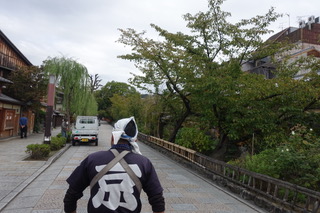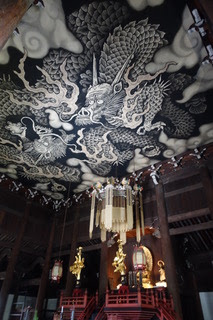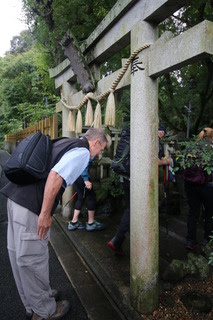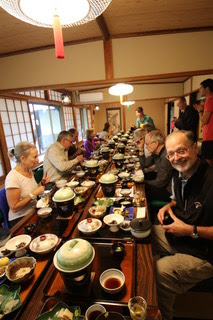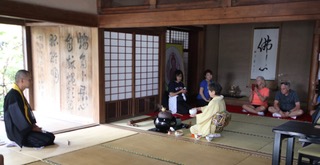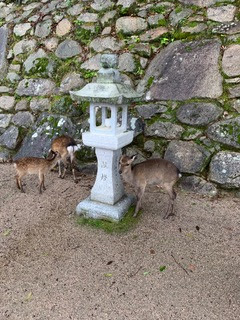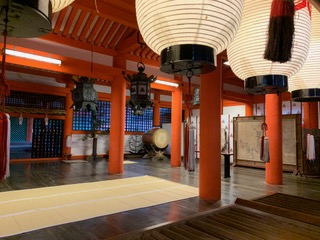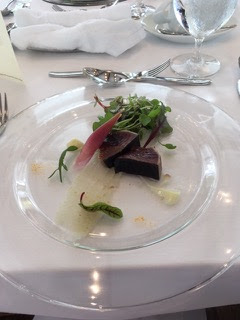Tuesday-Wednesday, October 15-16. After a nonstop early-morning Tuesday flight from Hartford to Los Angeles, we flew 12 1/2 hours on Japan Airlines across the International Date Line (advancing a day) to a Wednesday evening arrival in Osaka. En route, we certainly started our immersion in Japanese cuisine. This is Pam's Irodori Gozen - "Selection of Seasonal Colorful Vegetables." Clockwise from the top left, she had Snow Crab and Radish in Ginger Sauce; Simmered Sea Bass and Eggplant; Japanese Omelette with Salmon Roe; Chicken Meatball with Miso Sauce; and Beef Tataki Salad with Citrus Soy Jelly. Meanwhile, Paul (whose palate is considerably less evolved) was more than content with a nice piece of Kobe beef and white rice.
From the airport in Osaka, we had a 1 1/2-hour train ride to Japan's ancient imperial capital Kyoto -- the meeting point for our Backroads group. Although Kyoto was expressly spared bombing during World War II and dozens, if not hundreds of historical sites have been preserved, a large modern city has developed all around them, as you can see in this scene outside the main train station on our arrival. Although we were slightly nervous about making our way to Kyoto on our own given our utter lack of any Japanese language ability, it turned out to be very easy ... much of the signage was in both English and Japanese and English-speaking helpers were easy to find and widely available ... there was even a separate taxi lane at the train station for "Foreign Friendly" cabs with drivers guaranteed to speak English. An extremely well-organized and welcoming country ... more on that later.
Thursday, October 17. After sleeping in following our late evening arrival in Kyoto, we had a whole day to ourselves before meeting the Backroads group. We took a two-hour ride around several historical neighborhoods in this rickshaw.
Our "driver," who was also the engine, spoke excellent English. He told us he'd been running his rickshaw for 14 years ... not surprisingly, he appeared to have not an ounce of body fat! He did show us that the length of the handles and the way the rickshaw is balanced actually makes it quite easy (for him) to pull it up inclines ... it was altogether pretty amazing.
We rode through a number of historic neighborhoods and stopped at a major Shinto shrine complex next to the tall pagoda you see at the head of this street. Lots of foreign tourists in this area!
Shinto, the ancient traditional religion native to Japan, and Buddhism (imported from continental East Asia) are the two principal religions in Japan. Although most Japanese today do not self-identify as religious, most do observe traditions and rituals from both Shinto and Buddhism ... they are seen as complimentary rather than competing. Shinto ... animalistic and naturalistic with literally uncountable thousands of "gods" ... is seen as the faith of living, while Buddhism's emphasis on achieving total consciousness and nirvana is seen as the faith for dying and the afterlife. Japanese say they live as Shintoists and die as Buddhists. This painted ceiling inside the Shinto shrine complex depicts Shinto gods hard at work dispensing favors and regulating human affairs and the natural world.
Throughout the historical sections of Kyoto, we saw many young women, a few young men and even some older couples attired in traditional Japanese kimonos... as you see in front of the storefront in this photo.
Our driver explained that the vast majority of these people are tourists, who rent their traditional garb from shops like this one when they visit Kyoto. We quickly noticed these all over the areas through which we passed. Our driver also noted that many of the kimono-wearing tourists aren't even Japanese, and began pointing out many Chinese among them.
All that said, Kyoto is still the main center in Japan of the tradition of the Geisha ... women who apply and are specially trained from their teens in dance, music and the arts of conversation to entertain men. This goes on largely in districts filled with tea houses where individuals and groups gather after work, but geishas -- who must not marry so long as they perform -- can also be independent and contract to serve and perform at corporate gatherings and the like elsewhere. This photo shows a street leading into one of the several geisha districts in Kyoto ... virtually deserted here at mid-morning. More to say on the geisha soon ....
Friday, October 18. We met our Backroads group after breakfast and shuttled to the Fushimi Inari Shinto shrine. Founded in the 8th century for worship of the Shinto god of rice and sake (and prosperity generally), Fushimi Inari is known for its pathways that wind through literally thousands of bright orange-red torii gates ... Shinto symbols meant to demarcate the line between the profane world and the sacred space of the shrine. Here, Paul (and each member of our group) bow to show respect as we enter through a torii gate into the shrine area.
Inside the shrine, we climbed steadily through hundreds of the torii gates. As Inari is the god of prosperity, many of the gates are placed by individuals or companies, bearing prayers for success in business.
We saw many of these warning signs about vicious monkeys ... but no monkeys.
At length we reached the main entrance to the shrine, where most tourists enter. We were glad we had come in through a side entrance and avoided the crowds.
From Fushimi Inari, we walked to lunch at a restaurant famous for its beautiful courtyard gardens.
We enjoyed our first real Japanese lunch of sashimi, vegetables, beef and tofu ...
... followed by a traditional folk dance by two geisha -- a maiko or "new geisha in training" on the left, and an experienced geiko on the right.
After their performance, the geisha answered our many questions through a translator. The maiko had applied to become a geisha with the support of her parents when she was 15, and is nearing completion of several years' study at an academy, focusing on traditional dance, music and the "art of conversation." While not a growing profession in modern Japan, they estimated that there are today 150-200 traditional geisha, mostly in Kyoto.
Saturday, October 19. After breakfast, we shuttled to Mount Daisen ... a very sacred place in Shintoism. Our gentle 2.8-mile walk through beech forests captured the essence of Japanese hiking. Though Japan is known more for its thriving culture and technological advancements than outdoor excursions, the Japanese are increasingly developing trails to explore the pastoral countryside. These hikes are designed to blend town and nature, and to craft an experience with a uniquely Japanese aesthetic, with tranquility and balance in mind. The colloquial term for this is shinrin-yoku, or "forest bathing."
At length we arrived at the Amido-do Buddhist Temple, which was largely constructed in the 8th century. A goken (Buddhist monk) introduced and led us in a silent meditation for about 20 minutes. Interestingly, if the monk perceives you are losing focus, he hits you on the back with a stick; if you note you are losing focus, you raise your hand and he comes over and hits you with the stick. Perhaps the hardest part was achieving and holding the desired cross-legged sitting position on the floor ... not easy if this is new and you are of a certain age! And the strain of this was very distracting ... even if you don't get hit with the stick! But it was fascinating to try it and then hear the monk (who had served for several years in a Buddhist temple in San Francisco) describe his own regimen of meditation and how it can challenge even him. Overall, a great experience.
From the temple, we proceeded a short distance to a guesthouse for a "Monk's lunch," prepared by the goken himself from edibles gathered from the local forest. Needless to say, it was entirely vegetarian, with all of the protein supplied by tofu in several of its seemingly endless forms. Don't be fooled by Paul's smile for the camera.
After lunch, we shuttled to the Adachi Gardens, which have been judged by experts to be the most beautiful gardens in Japan (and that's saying something!). They surround an art gallery, and can only be viewed from inside it through plate glass walls.
You can get a sense of the scale of the gardens from these photos, but no photos - especially like these taken on a misty, gray day through windows - can truly convey the perfection and precision with which every plant and every scene in the gardens has been planned, executed and maintained. They are simply stunning.
Sunday, October 20. After sailing overnight across the Sea of Japan (or, as the Koreans prefer, the East Sea), at Mid-day we reached Busan, South Korea's largest port and second largest city. At the nadir of the Korean War, the combined North Korean and Communist Chinese forces pushed the United Nations forces all the way down the Korean peninsula to a last-stand around Busan, in what became known as the "Busan Perimeter." After a period of siege, General Douglas McArthur's bold gamble on an amphibious landing far behind enemy lines at Inchon relieved the pressure on Busan, and enabled the trapped UN forces to break out of the Busan Perimeter. Ultimately, they pushed the enemy forces all the way back up the peninsula to north of Seoul, where the 38th parallel marks the armistice line that today divides the two Koreas.
In Busan, we had a tour and lunch at the Jagalchi Fish Market -- Korea's largest -- which begins with vendors ringing the outside of an enormous central building.
This photo inside gives a sense of the scale of the market ... the main floor is easily the size of a football field, with row upon row of vendors selling more live, fresh, frozen and otherwise uncertain varieties of seafood than one can imagine.
The second floor, which is equally large, holds dozens of restaurants. Each is associated somehow with a number of the vendors down below, so that you can make your selections from the vendors, and then go upstairs and eat them at the associated restaurant. As you can see, the entire place ... outdoors, indoors, both floors ... was absolutely packed in the middle of the day on a Sunday. Amazing!
We were served a pre-fixe variety of seafood, quite unlike anything any of us had ever encountered in previous travels. Probably the most exotic (and perhaps least appetizing) were "Sea Worms" and these octopus tentacles -- which were so fresh, they were literally still wriggling around on the plate. One or two braver souls tried them and survived, but neither of us had quite the nerve. Our Backroads guides must have heard privately from others in our group, because cooked meats and cooked, recognizable fish were included in all of our onshore meals after this ... and spirits rose accordingly!
The Fish Market sits in the heart of Busan's modern, bustling commercial center.
But even in the midst of modernity, one still sees sidewalk vendors selling varieties of hand-harvested seaweed ... as they have for centuries.
From the Fish Market, we shuttled to the Gamecheon Cultural Village ... Busan's #1 tourist attraction. Settled initially by Korean War refugees, in the 1950s Gemecheon was a hillside shanty town, with thousands living in shipping containers or worse, without electricity or running water. Beginning in the 1960s, the residents slowly began to build brick and concrete structures with materials provided by the government. In 2009, the government decided to invest in Gamecheon to provide modern infrastructure.
Today, Gamecheon is a colorful, thriving home for local and international artists ... the quintessential quirky "arts district." Note these "birds" roosting atop a building overlooking the main avenue ...
Looking closer, they aren't birds at all ... their faces are actually of neighborhood residents!
Keeping with the artsy theme, we saw a number of young Korean women wearing the traditional Korean han-bok.
We climbed the hillside through narrow alleyways and up many flights of steps, passing lots of art galleries and tourist shops and sellers like this friendly gentleman.
Finally, we reached an observation terrace with this extraordinary panorama of this unique and colorful district. What a transformation from its origin as a grim refugee camp!
From Gamecheon, we shuttled back to the ship. As night fell, we passed back under the Busan bridge for our overnight journey back to Japan.
Monday, October 21. We anchored at Nagasaki, and after breakfast shuttled to Sakai National Park for a 2.8-mile hike.
From the hiking trail, we looked out over the adjacent Kujukushima ("99 Islands") National Park. After the hike, we went kayaking on the Inland Sea among these small islands ... we did not take our cameras on the kayak for fear of drowning them, but it was lots of fun.
On the hike, we encountered this old cemetery, and our local guides provided more detail and perspective on Japanese burial customs.
As many of them do, the trail also passed through a village, and we saw these schoolchildren playing in a schoolyard surrounded by typical Japanese village homes.
After this very active morning of hiking and kayaking, we had a delightful picnic lunch in the forest. This was one of the first days on our trip with weather good enough to eat outside, and we greatly enjoyed it.
After lunch, and still a little damp from our kayak adventures, we shuttled back to the ship.
Tuesday, October 22. After breakfast and a quick shuttle ride from the port of Kagoshima, we took a high-speed "bullet" train to Izumi. The Japanese train system is modern, comprehensive, comfortable, easy to navigate in English and absolutely punctual to the minute. And the conductors bow to the passengers on entering and leaving each car when they walk through to check tickets! From the Izumi train station we took a short "forest bath" hike to the area of the Izumi-Fumoto Samurai Residences.
Built to help secure Izumi against threatening warlords more than 400 years ago after the fall of the shogun, the preserved residences of the samurai warriors have changed little since that bygone era.
The neighborhood is notable also for its highly-decorated manhole covers!
After our morning walk, we enjoyed a delicious picnic lunch in a square near the Residences.
Then, with the assistance of a number of ladies, we all donned kimonos. It's quite a complicated production!
That was in preparation for an elaborate Japanese tea ceremony in one of the Residences. Here, we are enjoying delicious little cakes that are served before the tea.
The preparation and serving of the tea itself, as well as the manner in which one consumes it, is highly ritualized. This lady was the leader, and explained much of the ceremony as she prepared the tea and led us through it.
Throughout the ceremony, we were entertained by these ladies playing this many-stringed koto, the national musical instrument of Japan.
As we entered and departed the Residence -- as every time we entered a Buddhist temple or Shinto shrine - we were supposed to step into or out of our shoes "outside" directly into or out of sandals "inside" on a wooden porch or entryway, without touching either the ground or the porch/entryway in our stocking feet. THIS IS NOT EASY ... and if you look closely, not everybody accomplished it.
After surrendering our kimonos, we walked to and through this charming local museum about the samurai on our way to the train station.
The bullet train whisked us back to Kagoshima and our beautiful ship Le Laperouse ...
... where we enjoyed a terrific concert of taiko drumming dockside before dinner. In every port, local groups would come to entertain and welcome our ship ... we learned this is all spontaneous and not organized by or coordinated with the cruise line. The Japanese are very concerned to be seen as friendly and welcoming to visitors, and they certainly are.
Wednesday, October 23. Early this morning, we docked in Uwajima on Shikoku, the smallest of Japan's main islands. After breakfast, we went ashore to hike a portion of the Shikoku Pilgrimage Trail ... a 750-mile route that connects 88 Buddhist temples on Shikoku. This chorus of unbelievably cute little schoolchildren headlined the local greeters as we left the ship.
Just past the kids, we got to walk through a gauntlet of very friendly samurai!
Shortly we arrived at Butsumoku-ji (Temple 42 on the Pilgrimage Trail).
Here, we were greeted by a monk and enjoyed another, more formal tea ceremony ... sans kimonos.
From the tea ceremony, we walked through the temple complex to another building at the far end of this path.
Here, we entered this splendid temple room. Note the statue of the Buddha at the far end of the chamber (left edge of this photo), and the large drum in front of the sunlit window.
As we sat on the floor, the monk played a traditional (and vigorous) Buddhist drum "hymn" ... for about 15 minutes, continuously! How he kept going was beyond us ... it was awesome.
As we emerged, these henro (pilgrims) arrived, in traditional white shirts. Although some tourist-pilgrims move from temple to temple by van or motor coach, many still walk, taking six weeks or so to complete the challenging journey. A much smaller number, plainly more pious than we could ever be, actually complete the Trail multiple times throughout their lives. At each temple, the pilgrims make offerings, recite chants and perform rites.
As we proceeded on the Trail from Temple 42, we walked past farms and fields and through small villages ... a beautiful land.
This little girl ran out of her house and accompanied us for quite a distance. She spoke no English, but picked and gave us a beautiful wildflower and was happy for us to take this photo. Her brother -- even younger -- also accompanied us, even further down the path. Their parents were nowhere to be seen, but they apparently have none of the fears that come so readily to our minds, in their tranquil, beautiful countryside.
Persimmon trees were much in evidence along our path.
This local farmer stopped to welcome us and chat, through the translation by our local guide. The little girl and boy turned out to be his grandchildren.
We entered a woodland area and passed this small lake ...
... large stands of very tall bamboo trees ...
... and giant ferns. At 3.2 miles, this was one of our longer and definitely most enjoyable walks on the trip.
We earned a nice snack of various veggie chips, crackers and edamame in a village just below Ryuko-ji (Temple 41). This restaurant was owned and run by an elderly couple ... the wife had been a famous entertainer earlier in life, and the walls were filled with photos of her and famous Japanese (including Prime Ministers) who had visited the restaurant.
Before we returned to the ship, Paul took an option to climb the stairway up to Temple 41, and took this photo from its entrance looking back down on the village and countryside below.
When we got back to the ship, more local folks had turned out to say hello ...
... though not all of them could stay awake for our arrival! A charming end to another scenic and very interesting day.
Thursday, October 24. Early in the morning, we docked in Ujima, the port of Hiroshima ... a modern city on Japan's largest island Honshu that was largely destroyed by the first atomic bomb dropped in history, on August 6, 1945. The port area is dominated by this Tower of Paradise, which was built in 1989 to commemorate the 100th anniversary of the port.
After breakfast, we took a ferry to Miyajima, a sacred island known for its ancient temples and forest. It is also known for its resident deer, that are everywhere in the village surrounding the ferry dock.
Not only tame, they are downright friendly little critters!
After a short walk through the village (and the deer), we reached Itsukushima ... a stunning Shinto shrine and World Heritage site. Just to the left of this photo, the shrine's iconic torii gate seems to float on the water of the Inland Sea at high tide ... sadly for us, it is currently completely enclosed in scaffolding as it undergoes restoration/ preservation for the upcoming 2020 Tokyo Olympics. This photo was taken at low tide ... at high tide the sea comes in and the entire temple complex is suspended on its stilts over the water.
Building may have begun on the site as early as the 6th century, but its development as the main Shinto shrine of the island is attributed to expansion activity in the late 1500s. That said, only one structure survives from that period, and the remainder of the complex grew mostly through the 17th century. The interior spaces of the shrine today are beautiful and elegant in their simplicity.
From the shrine, we ascended this long stairway to the Buddhist Daisho-in temple complex at the base of Mt. Maisen. Sadly, a complete white-out and rain quashed our plan to hike up through the mountain forest ...
... but the statues and gardens of the temple complex provided plenty to see.
The Buddhas at Daisho-in are almost whimsical in their diversity and specialization. We're not sure what's in the pitcher, but this deity seems to be listening for your prayer to have some!
Yes, these three little guys are "hear no evil, see no evil, speak no evil." The faithful knit the little caps, to keep them warm.
We came to this amazing hall, which contains shrines side-by-side for each of the 88 temples on the Shikoku Pilgrimage Trail. People leave a great variety of small gifts and prayers at the shrines for the temple(s) of their choice.
On the way back down toward the ferry dock, we descended a trail through about 500 more little Buddhas ... each unique and with a special purpose or emphasis for prayers, and all bearing the knitted caps. A large map (unfortunately, all in Japanese) categorized them and detailed their locations along the trail, for pilgrims seeking particular ones.
A fast ferry took us directly from Miyajima to the Hiroshima Peace Park and Memorial Museum. This photo shows Hiroshima's main railway station today as it was immediately following the atomic explosion -- one of the only and certainly the most significant structure left standing in a 2-kilometer radius from ground zero.
On our ship, we had learned to make origami (folded paper) cranes. With many thousands of Japanese schoolchildren and international visitors, we were able to leave our cranes in these cabinets in the Peace Park as an expression of hope for peace.
We were able to visit the Memorial Museum, in which the horrors of the atomic explosion and its aftermath are presented in extraordinary detail and full candor. Photos are not permitted, and it is a grim and tough experience never to be forgotten. In the midst of the Memorial Park, we visited the Hiroshima Peace Arch, which is the central memorial to all victims of the atomic blast. Through the Arch, you can see framed the ruin of the railway station. We were a somber group as we returned to the ship and weighed anchor for the overnight cruise to Tamano and our last full day in Japan.
Friday, October 25. Some 3,000 islands dot the Inland Sea. After breakfast, we took a short ferry ride to spend our last day exploring just one: Naoshima. In the 1980s, a private investor purchased a large portion of Naoshimaand set out to revitalize it using art. Today, it is an art-lover's paradise, brimming with otherworldly outdoor installations, captivating architecture and several upscale museum galleries. This installation is near the entrance of one of them ... the Benesse House Gallery.
Yayoi Kusama, one of Japan's most famous modern artists and an influence on Andy Warhol, created this giant pumpkin at the end of a pier near the Benesse House Gallery in 1994. It has become the most photographed art installation on Naoshima, and is so iconic that the island is often referred to as the "island of the Giant Pumpkin."
During our 4-mile walk, we encountered dozens of outdoor installations, like this arch framing a view of the Inland Sea.
On Naoshima, stone Buddhist figurines with small signs reading "No. X Temple" were set up in the 17th century as part of an 88-temple pilgrimage route on Naoshima (a la Shikoku). They inspired this 2006 installation Tsuyoshi Ozawa inland across a small pond from the trail. The 88 Buddhas here are made from slag produced by burning industrial waste on nearby Teshima Island, and are intended to convey both positive and negative aspects of the history of the Inland Sea.
Further along, the path passed through this field of arranged, but not really sculpted large rocks...
... and this very geometric trio occupying a promontory with a beautiful view out over the Inland Sea.
The Giant Pumpkin was not the only whimsical installation ... as evidenced by this Warhol-esque Giant Trash Can commenting on our throw-away society ...
... and a full field of giant, technicolor animals.
After this enjoyable and interesting art walk, we felt we had earned what turned out to be the best meal we had in Japan, at the Benesse House Gallery's Terrace Restaurant. This is Marinated Bonito with Microgreens ... Yum!
After such a fine lunch, we were happy to find this nearby mirrored installation that made us look taller and thinner! We toured the Bennesse House Gallery and the Chichu Art Gallery ... neither allowed photographs ... before ferrying back to the ship and a long, but fascinating final day.
Saturday, October 26. After gathering one last time to bid each other, our three Backroads and two local guides farewell, we all headed for trains and planes to continue our travels. We were grateful for this opportunity to acquaint ourselves with the beauty, people, history, culture and cuisine of the Land of the Midnight Sun!
P.S. - After we reached Osaka International Airport to await our flight to Honolulu, Paul discovered he had left his backpack in the overhead on our 1 1/2-hour train ride from downtown. With little hope, we returned to the airport train station to see if anything could be done. The first employee we spoke with at the ticket office referred us to a young man standing in a window about 40 feet away. He spoke little English, but just enough to understand Paul's explanation. Without saying much in reply, he disappeared in the back of the office ... and miracle of miracles ... he held up Paul's backpack, completely intact! Apparently, those train conductors who bow at every doorway also sweep every train car at each end of the line ... what organization and efficiency! Talk about ending a visit on a high note!
***THE END***



